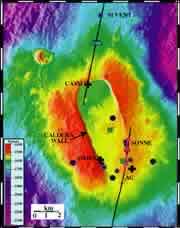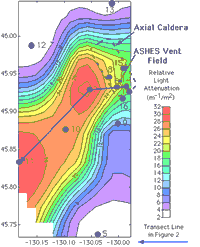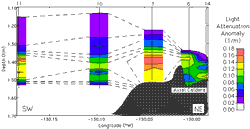1998:
Axial Volcano Eruption
Juan de Fuca Ridge
First submarine volcanic eruption at an instrumented site The 1998 eruption at Axial Volcano occurred, for the first time, at a site where we had installed monitoring instruments ahead of time. Prior to the eruption, VENTS had deployed a battery of instruments to measure ground deformation and water column temperature and flow. A response cruise immediately after the eruption in January found enormously increased hydrothermal activity compared to the previous 15 years of observations. This activity produced an intense plume streaming out of the caldera to the SW. Axial Volcano appears to be an excellent choice as the site of the New Millennium Observatory (NeMO). Preliminary
Scientific Results from the WECOMA Response Cruise The following is a capsule summary of initial results from the recent cruise of the Axial Response Team (ART) on the R/V WECOMA event response cruise of February 9-16, 1998. Despite the preliminary nature of the data, many exciting observations are already in hand. Despite almost unrelenting bad weather, all the major goals of the cruise were accomplished. Eight ocean bottom hydrophones (Spahr Webb, SIO) were deployed around the intersection of the south rift zone and the summit caldera, the earliest by far such instruments have been deployed after a seismic event. Sixteen CTD/water sampling stations were occupied, sufficient to document extensive new venting at Axial Volcano.
Hydrothermal discharge from the summit of Axial is roughly an order of magnitude greater than before the event. Plumes with temperature anomalies approaching 0.2°C and intense light attenuation values fill the south end of the caldera, rising at least 200 m above bottom. These temperature anomalies are probably the most intense anywhere on the Juan de Fuca Ridge at present, and are about twice those seen after the CoAxial eruption. The plume was tracked ~20 km to the southwest, where it was as intense as in the caldera. The areal pattern of integrated light attenuation anomalies indicates the plume is advecting steadily to the southwest (see Figure 1), in agreement with past current meter measurements.
Preliminary results from Scanning Electron Microscope studies of samples from Stations 11 and 1 are available. Station 11, farthest from the caldera (Figure1),
contains many angular glass shards up to 95 micrometers in diameter. This is the first time glass shards have been detected in a hydrothermal plume. Many of these shards have particles attached to them that appear to be precipitated halite. The precipitation of halite coatings on altered glass surfaces is consistent with heating seawater to temperatures of >400°C at 1500 m depth. Similar coatings were found on basalt from the CoAxial eruption in 1993. Many small particles of high iron concentration were also observed. While these particles were of similar size to iron oxides from past eruptive sites, their shape was more angular than then typically round globular shape seen in the past. Chemical analysis showed that these particles also contained halites and a higher than usual phosphorus to iron ratio. In addition, analysis of particles from Station 1, at the southeast corner of the caldera, show abundant elemental sulfur. The SEM evidence strongly suggests a lava eruption on the caldera floor, probably centered in the southeast corner of the caldera.
A northeast-southwest transect of light attenuation anomalies (indicative of the mass concentration of suspended hydrothermal particles) through the plume shows that the plume thickens and shallows downstream from the caldera (Figure2). Changes in intensity along the transect may arise from one or more causes. Fluctuations in the current speed may vary the residence time of water over the active vent sites in the caldera. More slowly flowing water accumulates more particles and a higher light attenuation anomaly. Alternatively, the variation may result from temporal changes in the intensity of venting, so that a transect downstream from the caldera is actually a history of venting since the eruption. In particular, the shallowing of the plume downstream may indicate more buoyant fluids were being vented initially than by the time of the ART cruise. This eruption is the first to occur in the presence of seafloor monitoring instruments. Two Volcanic System Monitors are in the caldera, and three temperature sensor/current meter moorings are arrayed along the southeast corner of the caldera, exactly at the center of the summit epicenter locations. These instruments, when recovered, will provide unique information on conditions at the start of the event. They will also provide current flow information for calculating heat and chemical fluxes from the caldera. Based on the plume trajectory, flow is highly uniform to the southwest. If this pattern is typical, it will be straightforward to make precise flux calculations. Also for the first time, we have recent and complete pre-event information on plume distribution and chemistry, taken last summer during a Vents cruise on the NOAA R/V RON BROWN. At that time plumes were present but very weak and close to the seafloor. Disappointments of the cruise were the absence of any event plumes, which would have been characterized by much greater rise height, and any sign of venting along the length of the south rift zone where a dike intrusion is thought to have occurred. The ART may have arrived after any event plumes had been advected away from the site. A few wispy plumes ~50-80 m thick almost 600 m above the caldera were found, perhaps remnants of event plumes. Five casts along the rift zone produced no sign of venting, very unlike the long length of plumes found above the track of the CoAxial dike intrusion. The rift zone will be surveyed in detail during the summer of 1998 from the NOAA R/V RON BROWN.
The Axial Response Team (ART):
Click here to see cruise reports from subsequent cruises to the Axial Volcano eruption site during the summer of 1998 |





